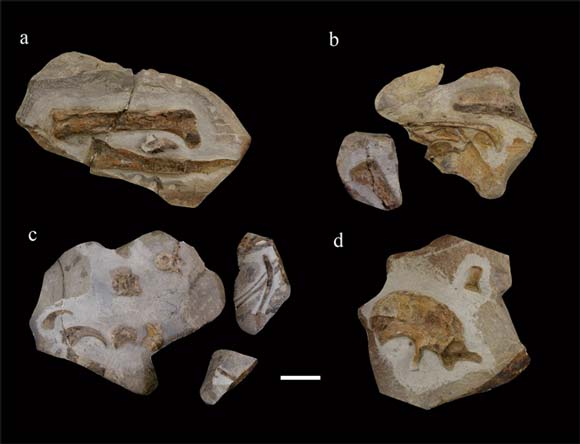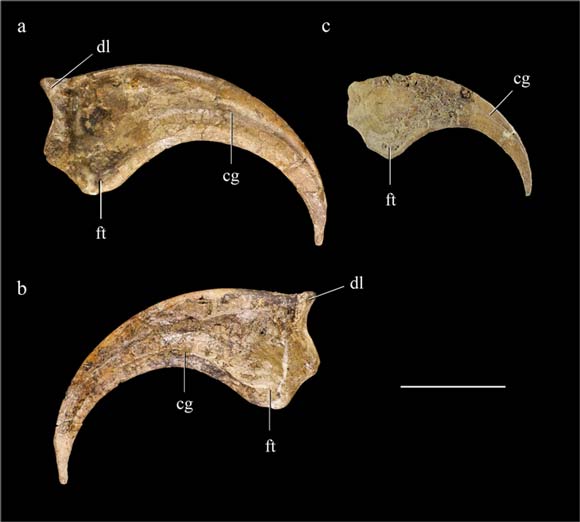Lingyuanosaurus sihedangensis – A New Species of Therizinosaur is Announced
Scientists from the Chinese Academy of Sciences in collaboration with the University of Alberta, have announced the discovery of a new therizinosaur based on fragmentary fossils from the Lower Cretaceous Jehol Group of Liaoning Province (north-eastern China). This is the third therizinosaur to have been named from the Jehol Group, joining Jianchangosaurus and Beipiaosaurus. These dinosaurs are approximately the same size, the researchers have put forward a number of theories to help explain why three similar-sized members of the Therizinosauridae could have potentially co-existed without directly competing.
The dinosaur has been named Lingyuanosaurus sihedangensis (pronounced: ling-you-an-oh-sore-us), the genus name honours the city of Lingyuan, whilst the trivial epithet refers to the town of Sihedang where the fossils were discovered.
Fossil Material Ascribed to Lingyuanosaurus sihedangensis Prior to Complete Preparation
Picture credit: Scientific Reports
The picture above shows some of the fossils used to name and describe this new species of dinosaur. Top left (a), limb bones consisting of a right femur and left tibia, whereas, (b) contains ribs, part of the right humerus and the ischium. Slab (c) consists of claw bones (manual unguals) and ribs, whilst (d), shows the right ankle bone (astragalus) and the left ilium. Note the scale bar equals 5 cm.
An Intermediate Position within the Therizinosauria
Described from a single, disarticulated but associated partial skeleton, the exact age of the fossils is disputed. The fossil-bearing strata at Sihedang have been assigned to the Yixian Formation in some studies but to the younger Jiufotang Formation in others. A phylogenetic analysis carried out by the authors places Lingyuanosaurus in an intermediate position within Therizinosauria. It has been placed between the early-branching therizinosaurs such as Falcarius, Jianchangosaurus, and Beipiaosaurus and the late-branching ones such as Alxasaurus and Therizinosaurus. Lingyuanosaurus sheds additional light on the evolution of major therizinosaurian characteristics, including the distinctive pelvic girdle and hindlimb morphology seen in this group.
A Drawing of a Typical Therizinosaur
Picture credit: Everything Dinosaur
Where Did Lingyuanosaurus Fit into the Jehol Biota?
Measuring around two metres in length, this is the third similar-sized therizinosaur to be assigned to this Early Cretaceous biota of northern China. The presence of three very similar types of dinosaur in the Jehol Group is unusual. Unless the region was particularly rich in resources, these dinosaurs could have been in direct competition with each other. The researchers put forward several possible explanations as to why three similar therizinosaurs have been identified.
- Firstly, the beds in which these therizinosaurs (Jianchangosaurus, Lingyuanosaurus and Beipiaosaurus), have been found are not precisely dated. The Yixian and the Jiufotang Formations were deposited over a span of at least 8 million years. It is possibly that these three dinosaurs could have been separated from each other by a considerable period of time, hundreds of thousands or even millions of years.
- Secondly, these three species are known from different parts of Liaoning Province. Whereas, Jianchangosaurus and Lingyuanosaurus were found at sites just a few miles apart, Beipiaosaurus heralds from more than 200 miles further north. There is some, albeit limited, evidence to suggest that during the Early Cretaceous the deposition of the Jehol Group occurred in multiple small basins, suggesting that the three Jehol therizinosaurs might have been separated by geographic barriers even if they were mutually contemporaneous.
- Thirdly, if these three therizinosaurs did live at the same time, in the same habitat, they might have occupied different niches in the ecosystem. The teeth of Jianchangosaurus are different (although the holotype represents a juvenile, so comparison with fully grown animals can be problematic), this suggests that Jianchangosaurus might have fed on different types of vegetation compared to Lingyuanosaurus and Beipiaosaurus. In addition, the ratio of limb bones in Beipiaosaurus is different to the other two dinosaurs, it might have been relatively slow in comparison with Jianchangosaurus and Lingyuanosaurus and therefore it could have had a more limited range.
Claw Fossils (Manual Unguals) – Lingyuanosaurus sihedangensis
Picture credit: Scientific Reports
The scientific paper: “A New Transitional Therizinosaurian Theropod from the Early Cretaceous Jehol Biota of China” by Xi Yao, Chun-Chi Liao, Corwin Sullivan and Xing Xu published in Scientific Reports.
Visit the Everything Dinosaur website: The Everything Dinosaur Website.









Leave A Comment